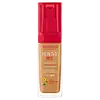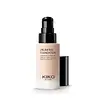What's inside
What's inside
 Key Ingredients
Key Ingredients

 Benefits
Benefits

No benefits
 Concerns
Concerns

 Ingredients Side-by-side
Ingredients Side-by-side

Water
Skin ConditioningDimethicone
EmollientCyclopentasiloxane
EmollientButylene Glycol
HumectantPEG-10 Dimethicone
Skin ConditioningAluminum Starch Octenylsuccinate
AbsorbentPhenoxyethanol
PreservativeSodium Chloride
MaskingDisteardimonium Hectorite
StabilisingDisodium Stearoyl Glutamate
CleansingDimethicone Crosspolymer
Emulsion StabilisingParfum
MaskingAlcohol Denat.
AntimicrobialAscorbyl Palmitate
AntioxidantGlycine Soja Oil
EmollientTocopherol
AntioxidantPropylene Glycol
HumectantPanthenol
Skin ConditioningAluminum Hydroxide
EmollientSilica
AbrasiveGlycerin
HumectantPyrus Malus Fruit Extract
Skin ConditioningSodium Hyaluronate
HumectantCucumis Melo Fruit Extract
Skin ConditioningPrunus Armeniaca Fruit Extract
Skin ConditioningPotassium Sorbate
PreservativeSodium Benzoate
MaskingBenzoic Acid
MaskingPantolactone
HumectantSorbic Acid
PreservativeBHT
AntioxidantCI 77891
Cosmetic ColorantIron Oxides
Mica
Cosmetic ColorantWater, Dimethicone, Cyclopentasiloxane, Butylene Glycol, PEG-10 Dimethicone, Aluminum Starch Octenylsuccinate, Phenoxyethanol, Sodium Chloride, Disteardimonium Hectorite, Disodium Stearoyl Glutamate, Dimethicone Crosspolymer, Parfum, Alcohol Denat., Ascorbyl Palmitate, Glycine Soja Oil, Tocopherol, Propylene Glycol, Panthenol, Aluminum Hydroxide, Silica, Glycerin, Pyrus Malus Fruit Extract, Sodium Hyaluronate, Cucumis Melo Fruit Extract, Prunus Armeniaca Fruit Extract, Potassium Sorbate, Sodium Benzoate, Benzoic Acid, Pantolactone, Sorbic Acid, BHT, CI 77891, Iron Oxides, Mica
Water
Skin ConditioningDimethicone
EmollientTalc
AbrasivePEG-10 Dimethicone
Skin ConditioningTrimethylsiloxysilicate
EmollientPentylene Glycol
Skin ConditioningHdi/Trimethylol Hexyllactone Crosspolymer
Isododecane
EmollientNylon-12
Phenoxyethanol
PreservativeDimethicone/Vinyl Dimethicone Crosspolymer
Skin ConditioningBis-PEG/PPG-14/14 Dimethicone
EmollientSodium Chloride
MaskingHydrogen Dimethicone
Magnesium Sulfate
Polypropylene
Sodium Dehydroacetate
PreservativeEthylene Brassylate
MaskingAluminum Hydroxide
EmollientDisteardimonium Hectorite
StabilisingBenzoic Acid
MaskingC24-28 Alkyl Methicone
EmollientMethicone
EmollientDehydroacetic Acid
PreservativePropylene Carbonate
SolventSilica
AbrasiveArabinose
HumectantEthylhexylglycerin
Skin ConditioningFucose
Skin ConditioningFucosyllactose
Skin ConditioningCI 77891
Cosmetic ColorantCI 77492
Cosmetic ColorantWater, Dimethicone, Talc, PEG-10 Dimethicone, Trimethylsiloxysilicate, Pentylene Glycol, Hdi/Trimethylol Hexyllactone Crosspolymer, Isododecane, Nylon-12, Phenoxyethanol, Dimethicone/Vinyl Dimethicone Crosspolymer, Bis-PEG/PPG-14/14 Dimethicone, Sodium Chloride, Hydrogen Dimethicone, Magnesium Sulfate, Polypropylene, Sodium Dehydroacetate, Ethylene Brassylate, Aluminum Hydroxide, Disteardimonium Hectorite, Benzoic Acid, C24-28 Alkyl Methicone, Methicone, Dehydroacetic Acid, Propylene Carbonate, Silica, Arabinose, Ethylhexylglycerin, Fucose, Fucosyllactose, CI 77891, CI 77492
Ingredients Explained
These ingredients are found in both products.
Ingredients higher up in an ingredient list are typically present in a larger amount.
Aluminum Hydroxide is a form of aluminum. It can be naturally found in nature as the mineral gibbsite. In cosmetics, Aluminum Hydroxide is used as a colorant, pH adjuster, and absorbent.
As a colorant, Aluminum Hydroxide may add opacity, or reduce the transparency. Aluminum hydroxide is contains both basic and acidic properties.
According to manufacturers, this ingredient is an emollient and humectant. This means it helps hydrate the skin.
In medicine, this ingredient is used to help relieve heartburn and help heal ulcers.
There is currently no credible scientific evidence linking aluminum hydroxide in cosmetics to increased cancer risk.
Major health organizations allow the use of aluminum hydroxide in personal care products and have not flagged it as a carcinogenic risk at typical usage levels.
Learn more about Aluminum HydroxideBenzoic Acid is used to preserve and adjust the pH of products.
The antimicrobial property of Benzoic Acid helps elongate a product's shelf life. Its main role is to reduce fungi growth and is not found to be effective at fighting bacteria. Therefore Benzoic Acid is always added along with other preservatives.
In its pure form, Benzoic Acid looks like a white crystalline solid. It has slight solubility in water.
The name of Benzoic Acid comes from gum benzoin, which used to be the sole source of deriving this ingredient. Benzoic Acid is the most simple aromatic carboxylic acid.
Benzoic Acid is naturally occuring in strawberries, mustard, cinnamon, and cloves. It has a slight scent but is not considered to be a fragrance.
Learn more about Benzoic AcidCi 77891 is a white pigment from Titanium dioxide. It is naturally found in minerals such as rutile and ilmenite.
It's main function is to add a white color to cosmetics. It can also be mixed with other colors to create different shades.
Ci 77891 is commonly found in sunscreens due to its ability to block UV rays.
Learn more about CI 77891Dimethicone is a type of synthetic silicone created from natural materials such as quartz.
What it does:
Dimethicone comes in different viscosities:
Depending on the viscosity, dimethicone has different properties.
Ingredients lists don't always show which type is used, so we recommend reaching out to the brand if you have questions about the viscosity.
This ingredient is unlikely to cause irritation because it does not get absorbed into skin. However, people with silicone allergies should be careful about using this ingredient.
Note: Dimethicone may contribute to pilling. This is because it is not oil or water soluble, so pilling may occur when layered with products. When mixed with heavy oils in a formula, the outcome is also quite greasy.
Learn more about DimethiconeDisteardimonium Hectorite comes from the clay mineral named hectorite. It is used to add thickness to a product.
It can also help stabilize a product by helping to disperse other ingredients.
Hectorite is a rare, white clay mineral.
Learn more about Disteardimonium HectoritePeg-10 Dimethicone is silicone with conditioner and emulsifier properties. It mostly acts as an emollient in skincare and and humectant in haircare.
According to the manufacturer, acidic formulations decrease the stability of this ingredient. It works best in neutral or near neutral formulations.
Phenoxyethanol is a preservative that has germicide, antimicrobial, and aromatic properties. Studies show that phenoxyethanol can prevent microbial growth. By itself, it has a scent that is similar to that of a rose.
It's often used in formulations along with Caprylyl Glycol to preserve the shelf life of products.
Silica, also known as silicon dioxide, is a naturally occurring mineral. It is used as a fine, spherical, and porous powder in cosmetics.
Though it has exfoliant properties, the function of silica varies depending on the product.
The unique structure of silica enhances the spreadability and adds smoothness, making it a great texture enhancer.
It is also used as an active carrier, emulsifier, and mattifier due to its ability to absorb excess oil.
In some products, tiny microneedles called spicules are made from silica or hydrolyzed sponge. When you rub them in, they lightly polish away dead skin layers and enhance the penetration of active ingredients.
Learn more about SilicaChances are, you eat sodium chloride every day. Sodium Chloride is also known as table salt.
This ingredient has many purposes in skincare: thickener, emulsifier, and exfoliator.
You'll most likely find this ingredient in cleansers where it is used to create a gel-like texture. As an emulsifier, it also prevents ingredients from separating.
There is much debate on whether this ingredient is comedogenic. The short answer - comedogenic ratings don't tell the whole story. Learn more about comegodenic ratings here.
The concensus about this ingredient causing acne seems to be divided. Research is needed to understand if this ingredient does cause acne.
Scrubs may use salt as the primary exfoliating ingredient.
Learn more about Sodium ChlorideWater. It's the most common cosmetic ingredient of all. You'll usually see it at the top of ingredient lists, meaning that it makes up the largest part of the product.
So why is it so popular? Water most often acts as a solvent - this means that it helps dissolve other ingredients into the formulation.
You'll also recognize water as that liquid we all need to stay alive. If you see this, drink a glass of water. Stay hydrated!
Learn more about Water